





Last November, LariAnn Garner introduced you to the very popular peace lily. This article will revisit this wonderful plant providing you with some details of the more popular cultivars available on the market as well as insights into the floral biology. The flowers may seem simple but their pollination is quite involved. If you want to see peace lily with fresh eyes, read on!
This article is a bit of a departure for me as I generally write about hardy perennials, trees and shrubs. In regards to tropical plants, I love my orchids but have only superficially learned some of the more popular tropical-origin houseplants. That changed recently when I assisted on a new education program at our botanical garden called ‘Topics on Tropics'. Besides finding information on the tropics in general, I was also given (actually volunteered) the task to find interesting facts about tropical aroids, orchids (of course!) and figs. It was during my research on aroids that I discovered some interesting aspects of peace lily or Spathiphyllum.
Peace lilies are often considered the most popular houseplant in North America. They were elected the ‘Desk Plant of the Year' in 2007. I will not go into their cultivation as LariAnn Garner (LariAnn) did a wonderful concise essay on the topic this past November. The horticulturist in me will concentrate on the various cultivars available on the market while the botanist in me will present information on their floral structure and pollination.
There are about 40 species of peace lily distributed throughout tropical Central and South America. We grow mostly hybrids derived from S. wallisii, a native of Panama and Costa Rica, and S. cochlearispathum from Columbia and Venezuela. The oldest known cultivar is ‘Clevelandii', which may be a selection from S. wallisii. Perhaps the most popular cultivar is ‘Mauna Loa', but in recent years there have been a rash of new cultivars released on the market. These differ primarily on the finish of the leaf (either shiny or matt), the leaf colour, the size of the flower and plant height. Unfortunately, when you purchase a peace lily you often have no idea of the cultivar. A plant may look small when you buy it, but with time may later become a monster! You are always better off if you can find out the cultivar name as you can then find more information on its ultimate size and habit.
Now that I have introduced the fact that there are many cultivars, I will note a few. It is perhaps best to divide them into their ultimate size. Overall, peace lilies fall into three size categories: small, medium and large. Small cultivars will attain a height of 12 to 18 inches and will be happy in 4- to 6-inch pots. They are ideal for tabletops and dish gardens. Mid-sized plants will reach 24 to 36 inches and are best in 6- to 8-inch pots. They are suitable for larger tabletops, plant stands and as floor specimens. The large selections will exceed 3 feet and may reach 6! They will require a 10- to 14-inch pot when mature and are best as floor specimens in large homes and offices. In tropical climates, the mid-sized plants make wonderful groundcovers for shaded areas.
There are close to 100 cultivars on the market. Among the smaller-sized peace lilies are ‘Annette', ‘Allison', Chopin', ‘Patrice', ‘Power Petite' and ‘Wallisii' (the latter not to be confused with the species S. wallisii). ‘Wallisii and ‘Chopin' are perhaps the most popular in North America.
The old cultivar ‘Clevelandii' falls into the mid-sized peace lilies. It is not that easy to find these days being superceded by ‘Mauna Loa'. Other mid-sized selections include ‘Mojo', ‘Prima', ‘Sonya' and ‘Sweet Pablo'. The last selection is touted as the fastest growing peace lily on the market.
The most popular giant peace lilies are ‘White Lightning', ‘Sensation' and ‘Figaro'. The last selection won the Best Flowering Plant at the Dutch Horti-fair in 1999.

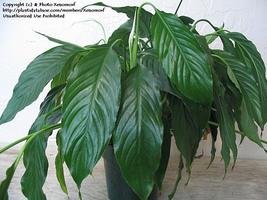
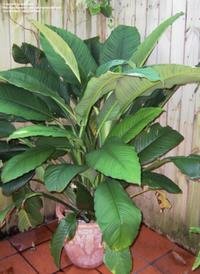
The three main sizes of peace lily are small, medium and large, as illustrated above
If coloured foliage is your thing, peace lilies can still accommodate you. There are several variegated peace lilies whose leaves are streaked, striped or splotched in white, cream or yellow. The variegation is NOT along the leaf edges as it is in most variegated plants. One of the oldest and still most available variegated cultivars is ‘Domino', a mid-sized plant. Other to look for include ‘City of Angels' (mid-sized), ‘Ceres' (mid-sized) ‘Hi Ho Silver' (mid-sized), ‘Cali Columbia' (dwarf) and ‘Sunny Sails' (large-sized). The so called golden-leaved selections are in reality more chartreuse and include ‘Golden Delicious' and ‘Golden Glow', both small-sized plants.

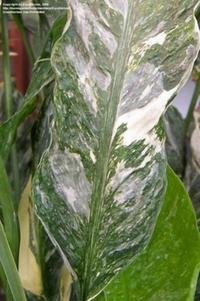
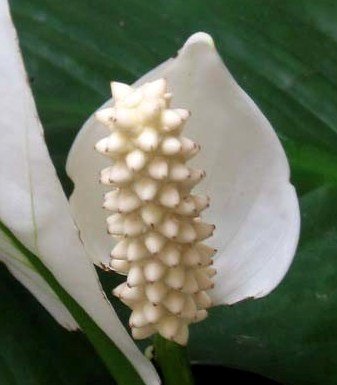
Details of the variegated cultivar 'Domino'; to the left is the species S. cannifolium, which exhibits the chartreuse foliage seen on the cultivars 'Goden Glow' and 'Golden Delicious'
Now that I have introduced you to some of the many peace lily cultivars, let's touch upon the interesting flowers themselves. Spathiphyllum are members of the Arum Family, Araceae. This family is characterized by its spathe-like flowers. The aroid "flower" is characterized by a compound inflorescence composed of numerous tightly packed florets on a rod shaped "spadix" which is often surrounded by a leaf like bract or "spathe" which may be brown-black through shades of green, white, yellow, pink, purple or red. Calla lilies (Zantedeschia) and flamingo flower (Anthurium) in particular are grown for their colourful spathes. The florets can be perfect flowers on a hermaphrodite spadix (i.e. can be functionally male and female) or in separate female and male ‘zones' on a monoecious spadix. The female flowers open first (i.e., are receptive to pollen) and after a period of time, ‘close'. Once closed the males open to release pollen. This delay between male and female flowers prevents self-pollination. Pollination is mostly via flies, bees or beetles that are attracted to the flowers by their odour.

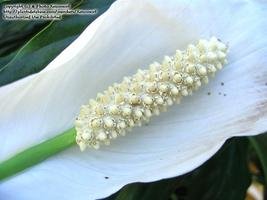
A close-up of the flowers showing the female phase (prior to pollen release) and the male phase (with pollen evidence around the base of the styles on the spadix)
Specifically the flowers of Spathiphyllum are hermaphroditic (functionally they are both male and female). Flowering lasts 9 to 12 days (although the attractive white spathe may be evident for weeks), with the female phase lasting 4 to 5 days, followed immediately by the male phase of 4 to 6 days. Pollen is continuously produced all over the spadix during the male phase. In the morning hours, plants produce a spicy to soap-like fragrance. The fragrance attracts Trigona and Euglossine bees (colonial stingless bees). During the female phase the bees collect wax from the conical styles on the spadix. During the male phase the bees concentrate on pollen collection instead. Experiments using marked bees have revealed that each bloom is ‘owned' by only 1 to 3 bees. These bees would visit the same flower during the 9 to 12 day flowering period, to the exclusion of other bees in the colony. Once the pollen and fragrance production ceases, the bees take ownership of a new peace lily blossom. During the afternoon hours when the flowers are not emitting their fragrance, the bees resume visiting other tropical flowers blooming nearby. When the bees move to a new peace lily flower, they inadvertantly carry some pollen along with them to pollinate the female portion of that new blossom. Isn't nature fascinating?! Now you will look at a peace lily flower in a new light! And thus concludes todays botanical seminar 'Peace Lily Pollination 101'.
I would like to thank the following members for the sue of their pictures: Equilibrium ('Domino'), giancarlo (large peace lily), grampapa (small peace lily), Monocromatico (S. cannifolium) and Xenomorf (medium peace lily and male close-up).
Copyright © www.100flowers.win Botanic Garden All Rights Reserved